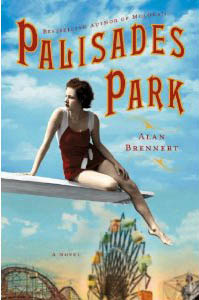by Vince Gargiulo
A new novel,
PALISADES PARK, by the award-winning writer, Alan Brennert, is scheduled to hit book stores on April 9, 2013. This is one book you will want to add to your library.
PALISADES PARK is not only a gripping tale of a New Jersey family, but a fabulous tribute to the famous Palisades Amusement Park.
This book is wonderfully written. Each character becomes an endearing part of the overall
storyline, with many of the them being well-researched real life people
who were part of the Palisades family. Although it is a fictional work, Mr. Brennert has taken Herculean efforts to ensure its accuracy. Every detail about the times and places mentioned in the book are historically accurate.
Click Here to Buy "Palisades Park"

The book begins in 1922 with a family outing to the New Jersey fun center. It weaves its way through time, with Brennert brilliantly mixing world events (The Depression, Pearl Harbor, World War II, the Civil Rights movement) into the storylines of both the characters and the New Jersey amusement park. The story spans five decades, ending in 1974.
The plot revolves around the Stopka family: Eddie and Adele and their children Toni and Jack. The characters in this book are skillfully blended together with actual park employees; Bunty Hill, Arthur Holden, Anna Cooke, Jack and Irving Rosenthal, John Rinaldi and more. They will all capture your heart, especially Toni (given name Antoinette, much to her dismay). While working at her parents' french fry stand at Palisades, Toni is drawn to the lure of the salt water swimming pool directly across the midway from the family concession. She learns the ins and outs of swimming, diving, and eventually high diving from a platform 105 feet in the air.
As Executive Director of the Palisades Amusement Park Historical Society, I was pleased to have been asked by Mr. Brennert for assistance in the research of Palisades Amusement Park. While I like to think I know all there is about the history of the park, there are always new things I discover from time to time. On those occasions that he would ask me a question about the park that had me stumped, Alan would call me back a week or two later with the answer. He is tenacious when it comes to staying true to history. I've never known an author who put more research into the writing of a novel than Alan Brennert. His detailed use of Palisades as the backdrop for this book will definitely bring back many fond memories for the baby boomers who grew up in the New York / New Jersey area.
When I turned the final page of the book, I was sad that it had ended... in my opinion, the mark of a great book!
PALISADES PARK is a must read or anyone who enjoys an engrossing novel, for everyone who ever visited the legendary Palisades Amusement Park, and for anyone who treasures their memories of happier days gone by.
###
FROM THE PUBLISHER:
PALISADES PARK SUMMARY:
Bestseller Alan Brennert’s spellbinding story about a family of
dreamers and their lives within the legendary Palisades Amusement Park.
Growing up in the 1930s, there is no more magical place than
Palisades Amusement Park in New Jersey—especially for seven-year-old
Antoinette, who horrifies her mother by insisting on the unladylike nickname
Toni, and her brother, Jack. Toni helps her parents, Eddie and Adele Stopka, at
the stand where they sell homemade French fries amid the roar of the Cyclone
roller coaster. There is also the lure of the world’s biggest salt-water pool,
complete with divers whose astonishing stunts inspire Toni, despite her
mother’s insistence that girls can’t be high divers.
But a family of dreamers doesn’t always share the same
dreams, and then the world intrudes: There’s the Great Depression, and Pearl
Harbor, which hits home in ways that will split the family apart; and perils
like fire and race riots in the park. Both Eddie and Jack face the dangers of
war, while Adele has ambitions of her own—and Toni is determined to take on a
very different kind of danger in impossible feats as a high diver. Yet they are
all drawn back to each other—and to Palisades Park—until the park closes
forever in 1971.
Evocative and moving, with the trademark brilliance at
transforming historical events into irresistible fiction that made Alan
Brennert’s Moloka’i and Honolulu into reading group favorites, Palisades Park takes us back to a time
when life seemed simpler—except, of course, it wasn’t.
ALAN BRENNERT/ABOUT THE AUTHOR:
Alan Brennert grew up in Edgewater, New Jersey, at the foot
of the Palisades. He won an Emmy Award in 1991 for his work as a
writer-producer on L.A. Law, and was nominated for two other Emmy Awards as
well as a Golden Globe. He won a Nebula Award for his story “Ma Qui.” The
author of the national bestsellers Moloka’i, a “Bookies” award-winner for Book
Club Book of the Year, and Honolulu, winner of Elle’s Lettres 2009 Grand Prix for Fiction, he lives in Sherman
Oaks, California.

 Laughing Sal, with her blond hair and polka‑dot dress, sold in 1994 at a Sotheby's auction for $6,900.
Laughing Sal, with her blond hair and polka‑dot dress, sold in 1994 at a Sotheby's auction for $6,900.







